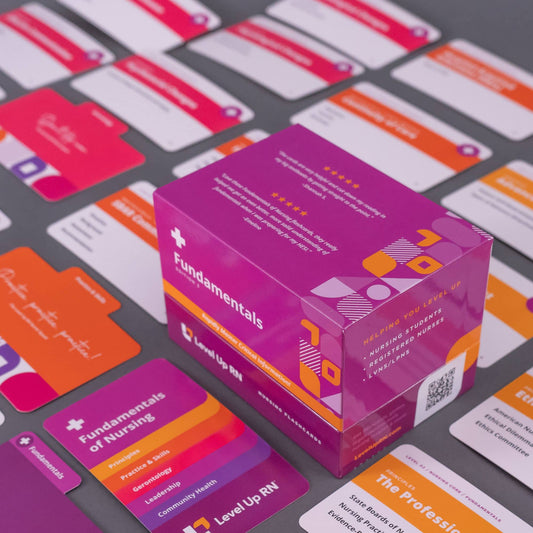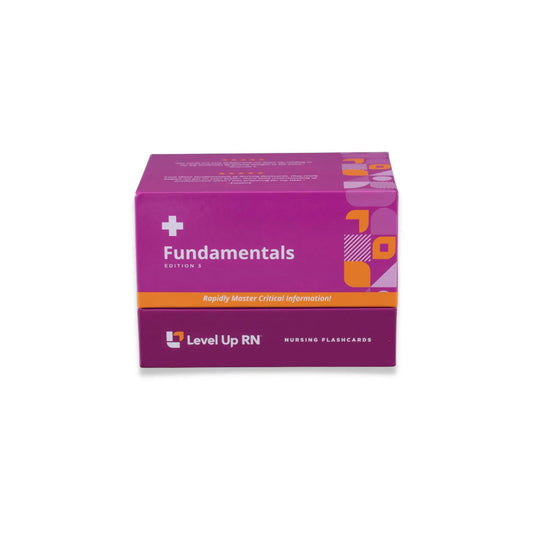This article focuses on basic care and comfort, including bed baths and bed making, oral care and denture care. It also covers the important topic of seizures and what to do with a patient who is on seizure precautions.
The Fundamentals of Nursing video series follows along with our Fundamentals of Nursing flashcards, which are intended to help RN and PN nursing students study for nursing school exams, including the ATI, HESI, and NCLEX.
Fundamentals of Nursing - Flashcards
Bed Baths
A bed bath simply means washing someone who is confined to a bed. Bed baths help keep the skin clean, which can prevent infections. A gentle bed bath can also be soothing for your patient.
Giving patients bed baths is a typical nursing duty, so it is important to know how to properly give a patient a bed bath.
How to give a bed bath
To start, fill a basin with warm water. You can also use disposable bath wipes.
It is important to ensure patient privacy when you give a bed bath. As you wash your patient, cover those areas you are not in the process of washing with a bath sheet. This is both for privacy and to keep the patient from getting cold.
When you give a bed bath, start with the eyes. Wipe the eyes with a damp cloth, without soap. This helps decontaminate the skin area around the eyes. Bacteria should be kept away from the eyes because it could cause an infection.
Next, wash the face, chest, arms, abdomen, legs, feet, and back.
When washing a patient's skin, first wet the skin, then gently apply a small amount of soap. Make sure all the soap is rinsed off and pat the area dry before covering it and moving on to the next area.
The last area to wash is the perineum — the patient's genitals and rectum. Before washing the perineum, change the water. Again, this is to prevent infection.
If your patient has a vulva, remember to wipe from front to back as you wash them. This avoids bringing fecal bacteria toward the urethra, which could lead to a urinary tract infection.
Bed making procedure
Bed making is another standard nursing duty, one you will perform often. Because of the potential for muscle fatigue or injury when you perform daily tasks, such as bed making or giving a patient a bed bath, it is important that you protect your back as you work, and that means making sure to raise the bed to waist height before you start.
Note that we do not shake out the linens when changing a bed in a hospital. This is to keep from dispersing any skin cells or other pathogens that might have accumulated on the linens.
When you replace old or soiled linens, immediately place them in a bin or soiled linen bag; do not pile them on the floor. This is another preventative measure to stop the dispersal of pathogens.
Patient oral care
Oral care is another fundamental nursing activity. Oral hygiene — the practice of keeping the oral cavity healthy through the cleaning of the gums, teeth, tongue, lips and, if necessary, dentures — can have a positive effect on the patient’s well-being and general health.
For patients who are alert and oriented, place an emesis basin (a shallow basin with a kidney-shaped base and sloping walls—contrary to its name, not usually used for vomiting!) underneath their chin, and provide a cup of water to help them with rinsing and spitting when you perform oral care.
If the patient is unconscious or cannot protect their airway as you perform oral hygiene, angle their head 45 degrees and turn them to the side to prevent aspiration (when something enters the airway or lungs by accident).
Keep suction readily available in case you need it to remove excess spittle or water from inside or around the patient's mouth.
Never place your fingers in a patient's mouth, regardless of whether they are alert, oriented, or unconscious. This will prevent the possibility of your being bitten, as well as keeping potential pathogens out of the patient's mouth.
Patient denture care
When it comes to patient denture care, remember that dentures can be very expensive, and it is important to handle them carefully.
Place some towels in the sink base when you clean dentures. If you accidentally drop them, their fall will be cushioned, which can keep them from breaking.
Cleaning dentures is a relatively easier task compared to brushing a patient's teeth. With dentures, you can brush them with a toothbrush and toothpaste, or you can use a dedicated denture cleanser.
Use cool water to rinse dentures, then store them in a labeled denture cup filled with denture solution or water. This will keep them from drying out. Make sure the cup is labeled with your patient's name and date of birth.
Seizures
A seizure is a burst of uncontrolled electrical activity between brain cells (also called neurons or nerve cells) that causes temporary abnormalities in muscle tone or movements (stiffness, twitching, or limpness), behaviors, sensations, or states of awareness.
Not all seizures are alike. Some are single events due to an acute cause, such as medication. Other seizures may be recurring seizures, also known as epilepsy.
Seizure precautions
While seizure prevention is a key long-term goal, preventing immediate physical danger to a patient who is at risk for seizures is the first priority. That means it is vital to establish and maintain seizure precautions, which are procedures designed to protect the patient from injury and include creating a safe environment around the patient and ensuring the proper equipment is available in the patient's room.
If you are treating a patient on seizure precautions, you must follow a number of protocols.
Pad the bed rails
First, make sure to pad the side rails of the patient's bed. This is to prevent a seizing patient from injuring their head if they hit it on the hard metal rails.
Usually the hospital will supply pads for a patient on seizure precautions, but you can also tape blankets and towels around the rails if necessary.
Access to oxygen
Make sure the room is equipped with oxygen and a delivery device. When a patient seizes, it could be due to a lack of oxygen. In addition, during a seizure, blood oxygenation levels could drop, which will require you to administer oxygen.
Suction
Make sure that suction equipment is set up and ready to be used in the patient's room in the event you need to suction the airways of a seizing patient.
Vital signs equipment
A seizure can change a patient’s pulse rate, often causing an increase in their heart rate. Occasionally, a seizure causes a patient's heart to slow, or even stop. So be sure the room has equipment that can track the patient's vital signs.
Nursing care during a seizure
Seeing someone have a seizure can be a frightening experience. As a nurse, you should be prepared to deal with this situation. Knowing how to care for a patient during a seizure is key to helping you keep your cool and be an effective nurse.
Lower to the floor
First, if the patient is standing or upright, lower them gently to the floor in as controlled a manner as possible. If you are alone, use your leg as a slide to help lower them to the floor.
Once the patient is on the floor (or if they are already lying in their bed), turn them onto their left side. This will keep them from choking on any secretions and decrease the risk of aspiration.
Loosen restrictive clothing
A seizure can happen anytime, anywhere. For example, if the patient is wearing a suit and tie, loosen the tie and unbutton the suit and shirt so they are not straining against something that's putting pressure on their airway.
This is to ensure the airway is “patent,” which means there is an open pathway between a patient's lungs and the outside world so they can breathe.
Protect the patient from harm
The number one priority when a patient is seizing is to protect them from harm. That means if there is anything in proximity that could hurt them — furniture, for example — it is moved out of the way. Furniture, like the side rails of a bed, is a potential hazard because the patient could bang their head on it.
Keep the mouth clear
Previous practice suggested that when a patient was having a seizure it was important to restrain them or put something in their mouth. This is no longer the case. Never restrain a patient or put anything in their mouth when they are seizing.
As noted above, if you restrain a patient, they can hurt themselves by pushing against the restriction. That is why we loosen clothing.
Similarly, putting something in a seizing patient’s mouth places you at risk of being bitten and your patient at risk of choking. So never put a belt, wallet, tongue blade, or your hand in a seizing patient's mouth.
These changes are due to what we call evidence-based practice. After years of following one set of practices, the evidence gained over time has proven that there is a better way to help a seizing patient, and that is why we no longer restrain them or put anything in their mouths.
Note the seizure’s start and stop times
As part of your nursing documentation, make sure that you note when the seizure started and when it stopped. This will help to discern which kind of seizure your patient has just experienced.
Nursing care post-seizure
After a seizure, your patient is going to be in the postictal phase — meaning their condition is somewhere between the end of the seizure and a return to their normal condition. During this phase, they may be highly disoriented, confused, upset, even combative.
It is important that you reorient your patient as much as possible. Try to keep them calm and reassure them they are safe.
At this time, you should record their vital signs and perform a brief neurological exam. This exam will help you discern how well the patient's brain and the rest of their nervous system are functioning and consists of assessing mental status, reflexes, pupillary responses, and motor and sensory functions. Need to remember these steps? Check out our Health Assessment Flashcards for Nursing Students.
Remember, in the postictal phase, your patients may be really out of it. They may be acting in a way that is not their normal self. Be kind and calm and compassionate, because they are most likely scared and confused.


